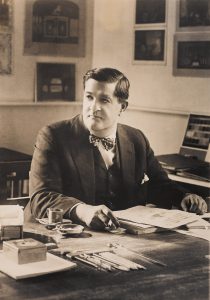Considering the staggering quantity, complexity and range of projects that Urban completed in the twenty-two years he spent in the United States, one wonders if he ever slept. Joseph Urban’s daughter, Gretl, noted that her father “enjoyed the pleasures of life with enormous gusto, but he enjoyed his work even more.” His gregarious demeanor and unmatched charm, paired with his dedication and talent, won him a bounty of connections and projects that would establish him as a design-star of the era, creating works that reflected and defined a modern mode of life.
Joseph Urban was born in Vienna, Austria, and studied architecture at the city’s Academy of Fine Arts in the late nineteenth century. During this period, many Viennese artists, including Urban, rejected historical precedents and embraced a new modern art. Urban arrived in America in 1911. Over the next two decades, his work across multiple media introduced aspects of European modernism to America and positioned him as one of the most influential designers of the early twentieth century.
LISTEN: Elaine Wormser on Joseph Urban
Transcript
My father knew Joseph Urban because my father represented someone in New York who had him do the Casino in the park. …The Central Park Casino was a wonderful place in the mid-twenties, … Joseph Urban did the setting, and it was a place where you had tea, dancing and a lot of artists and, well, new people went there. …So, your father knew Joseph Urban personally? Businesswise, businesswise. And we all knew him, of course, when he came to Chicago. He visited to look at all his settings primarily. …Did you ever meet Joseph Urban? Oh, yes, many times. He was a little fat, short thing. …As I say, he was primarily a set designer, a Viennese set designer.
– Elaine Wormser Reis interviewed by Anita Ellis, Otto Thiem, and Ellen Christenson, September 26, 1985. Curatorial file, Cincinnati Art Museum.
